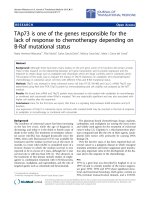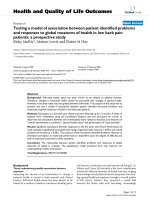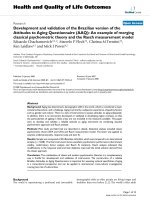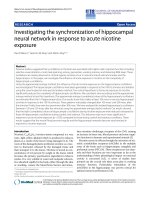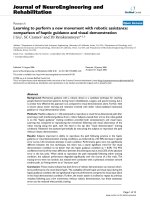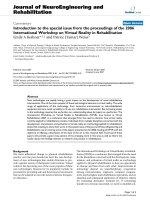báo cáo hóa học: " Responses to Comments of Weis" pptx
Bạn đang xem bản rút gọn của tài liệu. Xem và tải ngay bản đầy đủ của tài liệu tại đây (144.48 KB, 2 trang )
LET T E R TO THE EDITOR Open Access
Responses to Comments of Weis
Na Guo
1
, Carlo A Marra
1,2*
, Fawziah Marra
3
Abstract
A response to Weis and Pasipanodya ‘Measuring health-related quality of life in tuberculosis: a systemic revie w -
Response’.
Letter to the Editor
We thank Weis and Pasipanodya for their valuable and
insightful comments on our published manuscript, Mea-
suring health-related quality of life in tuberculosis: a sys-
temic review [1]. However, we want to address their
question regarding our statement “A validated tubercu-
losis-specific quality of life instrument was not located”.
When we searched for a “validated tuberculosis-specific
quality of life instrument” for our literature review,
there were two requirements that we had determined
apriori. Firstly, the quality of life (QoL) instrument had
to be originally designed and tail ored specifically to
ass ess a tuberculos is (TB) population; and secondly, the
involved QoL instrument had to be validated in various
TB populations.
Subjective measurements, such as QoL, are always
prone to inherent biases. Validation is an important pro-
cess involving the accumulation of evidences to provide
a sound scientific basis to support the inferences of
their psychometric properties. In addition, the qu ality of
validation evidences is very important. Although there is
no rule of thumb when validating a QoL instrument, a
number of considerations should be taken into account
- for example reliability, validity and responsiveness,
representative samples of the targeted population,
appropriate analysis techniques, and controls over plau-
sible confounding factors [2].
Through our literature review, we only found one
QoL instrument, the DR-12 [3], which was designed
specifically for use in TB infected pop ulations. However,
as we stated in our manuscript [1], it has only been
used once in a sample of active TB patients and the
validation was not do ne in a syst ematic fashion. More
applications with better validation methods are needed
to further est ablish the psychometric properties of the
DR-12.
Finally, we agree with Weis and Pasipanodya that item
banking is a promising direction for QoL measurements.
Item banking is a large collection of items that are mea-
suring the same health construct and calibrated onto
common scales using item response theory (IRT) based
approaches. A new generation of health outcomes mea-
surements, computerized adaptive testing (CAT), which
combines modern measurement theory, IRT, with
advanced computer technologies, has the potential to
optimize measurement precision [4-8].
Author details
1
Collaboration for Outcomes Research and Evaluation (CORE), Faculty of
Pharmaceutical Sciences, University of British Columbia, Vancouver, BC,
Canada.
2
Centre for Health Evaluation and Outcome Sciences (CHEOS),
Providence Health Care Research Institute, Vancouver, BC, Canada.
3
Faculty
of Pharmaceutical Sciences, University of British Columbia, Vaccine and
Pharmacy Services, British Columbia Centre for Disease Control (BCCDC),
Vancouver, BC, Canada.
Received: 2 December 2009
Accepted: 15 January 2010 Published: 15 January 2010
References
1. Guo N, Marra F, Marra C: Measuring health-related quality of life in
tuberculosis: a systematic review. Health Qual Life Outcomes 2009, 7:14.
2. Streiner DL, Norman GR: Health measurement scales: A Practical Guide to
Their Development and Use. Oxford Medical Publications, 3 1995.
3. Dhingra VK, Rajpal S: Health related quality of life (HRQL) scoring in
tuberculosis. India J Tuberc 2003, 50:99-104.
4. Bjorner JB, Kosinski M, Ware JE Jr: Calibration of an item pool for
assessing the burden of headaches: an application of item response
theory to the headache impact test (HIT). Qual Life Res 2003, 12:913-933.
5. Fliege H, Becker J, Walter OB, Bjorner JB, Klapp BF, Rose M: Development
of a computer-adaptive test for depression (D-CAT). Qual Life Res 2005,
14:2277-2291.
6. Lai JS, Cella D, Dineen K, et al: An item bank was created to improve the
measurement of cancer-related fatigue. J Clin Epidemiol 2005, 58:190-197.
7. Lai JS, Cella D, Dineen K, Bode R, Von Roenn J, Gershon RC, Shevrin D:
Assessment of health-related quality of life in arthritis: conceptualization
* Correspondence:
1
Collaboration for Outcomes Research and Evaluation (CORE), Faculty of
Pharmaceutical Sciences, University of British Columbia, Vancouver, BC,
Canada
Guo et al. Health and Quality of Life Outcomes 2010, 8:6
/>© 2010 Guo et al; licensee BioMed Central Ltd. This is an Open Access article distributed under the terms of the Creative Commons
Attribution License (http://c reativecommons.org/licenses/by/2.0), which permits unrestri cted use, distribution, and reproduction in
any medium, provided the original work is properly cited.
and development of five item banks using item response theory. Health
Qual Life Outcomes 2006, 4:33.
8. Walter OB, Becker J, Bjorner JB, Fliege H, Klapp BF, Rose M: Development
and evaluation of a computer adaptive test for ‘Anxiety’ (Anxiety-CAT).
Qual Life Res 2007, 16(Suppl 1):143-155.
doi:10.1186/1477-7525-8-6
Cite this article as: Guo et al.: Responses to Comments of Weis. Health
and Quality of Life Outcomes 2010 8:6.
Publish with Bio Med Central and every
scientist can read your work free of charge
"BioMed Central will be the most significant development for
disseminating the results of biomedical researc h in our lifetime."
Sir Paul Nurse, Cancer Research UK
Your research papers will be:
available free of charge to the entire biomedical community
peer reviewed and published immediately upon acceptance
cited in PubMed and archived on PubMed Central
yours — you keep the copyright
Submit your manuscript here:
/>BioMedcentral
Guo et al. Health and Quality of Life Outcomes 2010, 8:6
/>Page 2 of 2
